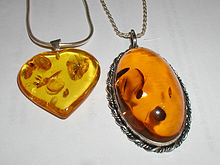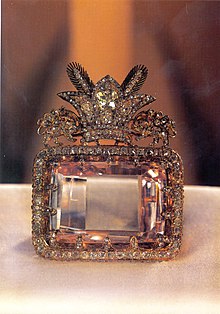Jewellery
From Wikipedia, the free encyclopedia
Jewellery or jewelry (/ˈdʒuːᵊlᵊri/) consists of small decorative items worn for personal adornment, such as brooches, rings, necklaces,earrings, and bracelets. Jewellery may be attached to the body or the clothes, and the term is restricted to durable ornaments, excluding flowers for example. For many centuries metal, often combined with gemstones, has been the normal material for jewellery, but other materials such as shells and other plant materials may be used. It is one of the oldest type of archaeological artefact – with 100,000-year-old beads made from Nassarius shells thought to be the oldest known jewellery. The basic forms of jewellery vary between cultures but are often extremely long-lived; in European cultures the most common forms of jewellery listed above have persisted since ancient times, while other forms such as adornments for the nose or ankle, important in other cultures, are much less common. Historically, the most widespread influence on jewellery in terms of design and style have come from Asia.
Jewellery may be made from a wide range of materials. Gemstones and similar materials such as amber and coral, precious metals,beads, and shells have been widely used, and enamel has often been important. In most cultures jewellery can be understood as a status symbol, for its material properties, its patterns, or for meaningful symbols. Jewellery has been made to adorn nearly every body part, fromhairpins to toe rings, and even genital jewellery. The patterns of wearing jewellery between the sexes, and by children and older people can vary greatly between cultures, but adult women have been the most consistent wearers of jewellery; in modern European culture the amount worn by adult males is relatively low compared with other cultures and other periods in European culture.
The word jewellery itself is derived from the word jewel, which was anglicized from the Old French "jouel", and beyond that, to the Latinword "jocale", meaning plaything. In British English, New Zealand English, Hiberno-English, Australian English, and South African English it is spelled jewellery, while the spelling is jewelry in American English. Both are used in Canadian English, though jewelry prevails by a two to one margin. In French and some other European languages the equivalent term, joaillerie there, may also cover decorated metalwork in precious metal such as objets d'art and church items, not just objects worn on the person.
Form and function
Humans have used jewellery for a number of different reasons:
- functional, generally to fix clothing or hair in place, or to tell the time (in the case of watches)
- as a marker of social status and personal status, as with a wedding ring
- as a signifier of some form of affiliation, whether ethnic, religious or social
- to provide talismanic protection (in the form of amulets)
- as an artistic display
- as a carrier or symbol of personal meaning – such as love, mourning, or even luck
Most cultures at some point have had a practice of keeping large amounts of wealth stored in the form of jewellery. Numerous cultures store wedding dowries in the form of jewellery or make jewellery as a means to store or display coins. Alternatively, jewellery has been used as a currency or trade good; an example being the use of slave beads.
Many items of jewellery, such as brooches and buckles, originated as purely functional items, but evolved into decorative items as their functional requirement diminished.
Jewellery can also symbolise group membership (as in the case, of the Christian crucifix or the Jewish Star of David) or status (as in the case of chains of office, or the Western practice of married people wearing wedding rings).
Wearing of amulets and devotional medals to provide protection or ward off evil is common in some cultures. These may take the form of symbols (such as the ankh), stones, plants, animals, body parts (such as the Khamsa), or glyphs (such as stylised versions of the Throne Verse in Islamic art).
Materials and methods
In creating jewellery, gemstones, coins, or other precious items are often used, and they are typically set into precious metals. Alloys of nearly every metal known have been encountered in jewellery. Bronze, for example, was common in Roman times. Modern fine jewellery usually includes gold, white gold, platinum, palladium, titanium, or silver. Most contemporary gold jewellery is made of an alloy of gold, the purity of which is stated in karats, indicated by a number followed by the letter K. American gold jewellery must be of at least 10K purity (41.7% pure gold), (though in the UK the number is 9K (37.5% pure gold) and is typically found up to 18K (75% pure gold). Higher purity levels are less common with alloys at 22 K (91.6% pure gold), and 24 K (99.9% pure gold) being considered too soft for jewellery use in America and Europe. These high purity alloys, however, are widely used across Asia, the Middle East and Africa. Platinum alloys range from 900 (90% pure) to 950 (95.0% pure). The silver used in jewellery is usually sterling silver, or 92.5% fine silver. Incostume jewellery, stainless steel findings are sometimes used.
Other commonly used materials include glass, such as fused-glass or enamel; wood, often carved or turned; shells and other natural animal substances such as bone and ivory; natural clay; polymer clay; Hemp and other twines have been used as well to create jewellery that has more of a natural feel. However, any inclusion of lead or lead solder will give an English Assay office (the building which gives English jewellery its stamp of approval, the Hallmark) the right to destroy the piece, however it is very rare for the assay office to do so.
Beads are frequently used in jewellery. These may be made of glass, gemstones, metal, wood, shells, clay and polymer clay. Beaded jewellery commonly encompasses necklaces, bracelets, earrings, belts and rings. Beads may be large or small; the smallest type of beads used are known as seed beads, these are the beads used for the "woven" style of beaded jewellery. Another use of seed beads is an embroidery technique where seed beads are sewn onto fabric backings to create broad collar neck pieces and beaded bracelets. Bead embroidery, a popular type of handwork during the Victorian era, is enjoying a renaissance in modern jewellery making. Beading, or bead work, is also very popular in many African and indigenous North American cultures.
Silversmiths, goldsmiths, and lapidaries methods include forging, casting, soldering or welding, cutting, carving and "cold-joining" (using adhesives, staples and rivets to assemble parts).
Diamonds
Diamonds were first mined in India. Pliny may have mentioned them, although there is some debate as to the exact nature of the stone he referred to as Adamas; In 2005, Australia, Botswana, Russia and Canada ranked among the primary sources of gemstone diamond production.
The British crown jewels contain the Cullinan Diamond, part of the largest gem-quality rough diamond ever found (1905), at 3,106.75carats (621.35 g).
Now popular in engagement rings, this usage dates back to the marriage of Maximilian I to Mary of Burgundy in 1477.







No comments:
Post a Comment